Why Has Demonetisation Become Relevant Again
While the year 2019 will bring with information technology formation of new Government after the elections in April 2019, the after effects of Demonetization that happened on November 8, 2016 even so haunt the Indian Economy. After more 2 years of Demonetization, Indian Economic Survey claims that the economy has done away with all the negative impacts of Demonetization. However, economical experts are of the view that the economy is still crying for a faster growth and footling objective has been achieved by the demonetization movement.
| MBA/PGDM Admissions 2022 Open | Utilize At present | |
|---|---|
| IMT Nagpur PGDM Admissions 2022 | BIMTECH Greater Noida Admissions Open |
| Praxis Business Schoolhouse Admission 2022 | EDII Ahmedabad PGDM Admission 2022 |
| IFIM College Bangalore MBA Admission 2022 | SRM University Chennai MBA Access 2022 |
| NDIM New Delhi PGDM Admission 2022 | ITM Mumbai PGDM Admissions 2022 Open |
| Amrita School of Business MBA Admissions 2022 | JIMS Rohini Delhi PGDM Admissions 2022 |
| Jaipuria, Lucknow Noida Jaipur Indore Admissions | Jaypee JIIT JBS Noida MBA Admission 2022 |
| VIT Academy MBA Admissions 2022 Open | IPE Hyderabad PGDM Admission 2022 Open |
| RV Plant of Management Admission 2022 | VJIM Hyderabad PGDM Admissions 2022 |
| IESMCRC Bombay PGDM Admissions 2022 | XIME Bangalore PGDM in Business Analytics |
Demonetization: Still Haunts Indian Economy
The Demonetization was appear as a surprise in the night on November 8, 2016. The Economic Survey of Bharat which was released just earlier the presentation of General Upkeep 2018 in Parliament emphasized that all the negative impact of Demonetization of Rs.500/- and Rs.grand/- currency notes has ended. However, the analysis in India and abroad has claimed that demonetization of November 2016 has failed to practise what it was supposed to do and its impact has turned out to exist more than protracted than initially expected.
Experts call up that even from the point of view of promoting digital coin, in that location was no need for the authorities to take put 86 per cent of all currency out of circulation. Studies have pointed out that very little black coin was caught. On August 30, 2017, the Reserve Banking company of India released its study on Demonetisation. The report said 99 per cent of the banned notes came back into the banking organization. This belies the Government claims that the Demonetization would affluent out the black money and counterfeit currency. Claiming the Demonetization as a wrong decision, as 99 per cent currency is back in the organization, it points to i of the 2 things -
Either the black money held in cash was very low, or The regime could not implement the demonetization efficiently due to which all the black money held in Rs. 500 and Rs. 1000 bank notes laundered back to the banking arrangement.
| GD Topics: Read 200+ GD Topics 2022 for MBA Admissions | |
| Russia Ukraine War: Reasons for Conflict & Impact on India | Union Budget 2022: Central Highlights; volition it propel postal service pandemic Economic Growth? |
| Crypto Currency: A bright hereafter or simply a fad | Privatization of Public Sector in India: A correct stride or selling family silver? |
| Social Media: A benefaction or a blight for society and individuals | E-Learning: A substitute for Classroom Learning? |
| Is Republic of india gear up for Electrical Vehicles | Coronavirus: Touch on of Covid 19 Third Wave in India; Vaccination Policy; Roadmap Ahead |
| Subcontract Laws Repealed: PM MODI withdraws the three farm laws | Demonetisation: Success & failures |
| Central Bank Digital Currency (CBDC): Impact on Indian Fiscal System & Cryptocurrency | Facebook rebrands to Meta: Is Metaverse a revolutionary engineering science, or just hype? |
Demonetization: Positive Impacts on Indian Economic systemClaimed
Economic Survey after careful review of Demonetization which was announced one and a half year back, has establish that the cash-to-GDP ratio has stabilized. It suggests a return to equilibrium:
- The Economic Survey says that India'due south Gross domestic product is set to grow at 7 to 7.5 percentage in 2018-19. This is an increase from its prediction of 6.75 percentage growth this fiscal year.
- The Economical Survey has cited exports and imports data to claim that the demonetisation effect was at present over. It claims that re-acceleration of export growth to xiii.half-dozen pct in the tertiary quarter of Financial Year 2018 and deceleration of import growth to 13.1 percentage is in line with global trends. This suggests that the demonetization and GST effects are receding. Services consign and private remittances are as well rebounding
- According to the statistics released in the Survey, the Demonetization had led to Rs 2.8 lakh crores less greenbacks (Equivalent to 1.8% of GDP) and Rs iii.8 lakh crores less high denomination notes (Equivalent to ii.5% of Gdp) in the Indian economic system.
- The Economic Survey has likewise clarified that income tax collections take touched new high with demonetization and introduction of GST, "From about 2 per centum of GDP between 2013-14 and 2015-16, they are likely to ascension to ii.3 percentage of Gdp in 2017-18, a historic high."
Grouping Discussion Topics & Tips: Learn the Facts
- Group Word (GD) is widely used for Admissions to top MBA colleges, Job interviews, and other selection process.
- GD Tips: Learn how to start a group word, take the pb, make positive impact, and score loftier.
- Tiptop 100 GD Topics: GD topics can be based on Current Affairs, Business & Economy, Social Issues, or Abstract.
- Prepare GD with MBAUniverse.com. Read 100+ GD Topics with Answers, Solutions. New topics added every calendar week.
Demonetization: Back footing and key facts
- On November eight, 2016, the Prime number Minister of India, Narendra Modi announced the Demonetization of all Rs.500 and Rs. 1,000 denominationbanknotes of the Mahatma Gandhi Series.
- The demonetization declaration fabricated the use of Rs.500 and Rs.thousand banknotes invalid past midnight of November 8.
- It was also announced that the new Rs.500 and Rs.2000 banknotes of the Mahatma Gandhi new series would be introduced in exchange for the old banknotes.
- The objective of demonetization as claimed by Regime of India was to curtail the black money running as shadow economic system and to stop the use of apocryphal greenbacks to fund illegal action and terrorism.
- The sudden nature of the announcement—and the prolonged greenbacks shortages in the weeks that followed—created significant disruption throughout the economic system, threatening economic output.
- The demonetization motion was heavily criticized equally poorly planned and unfair, and was met with protests, litigation, and strikes.
The announcement was sudden and unscheduled. Information technology was a alive television address at 8PM on November 8, 2016. In the days following the demonetisation, the state faced severe greenbacks shortages with severe detrimental furnishings beyond the economic system. People seeking to exchange their depository financial institution notes had to stand in lengthy queues, and several deaths were linked to the inconveniences caused due to the blitz to exchange cash. Equally the cash shortages grew in the weeks following the motion, the demonetization was heavily criticised past prominent economists and by world media.
| BBA Admissions Open 2022 | Apply At present! | |
|---|---|
| JAGSoM BBA Programme Admissions 2022 | TAPMI BBA Honours at Bangalore Admissions |
| IMS Ghaziabad (University Courses Campus) BBA Admission | UPES Academy, BBA Admissions 2022 |
Merits-Demonetization Favoured India'southward Economic Growth
- Demonetization policy of the Government has been termed every bit the greatest financial reform that aimed to curb the black money, abuse and counterfeit currency notes.
- All the people who are not involved in malpractices welcomed the demonetization equally the right move.
- Demonetization was done to assist Republic of india to get corruption-costless as it will be hard at present to keep the unaccounted cash.
- Demonetization will help the government to track the blackness money and the unaccounted cash will at present flow no more and the amount collected by means of revenue enhancement tin be meliorate utilized for the public welfare and development schemes.
- Ane of the biggest achievements of demonetization has been seen in the drastic curb of terrorist activities equally it has stopped the funding the terrorism which used to get a heave due to arrival of unaccounted cash and faux currency in big volume.
- Money laundering volition somewhen come to halt as the activity can easily be tracked and the coin can be seized by the authorities.
- Demonetization aimed to end the running of parallel economy due to circulation of simulated currency as the banning of Rs.500 and Rs. 1000 notes will eliminate their circulation.
- The unaccounted greenbacks could be deposited in the Pradhan Mantri Garib Kalyan Yojana after paying fifty% tax. The money will remain deposited for 4 years with the bank without incurring any interest. Withal, afterward iv years the amount will be returned. This amount tin can be utilized for social welfare schemes and making the life of low income groups better.
- The Public Sector Banks which were reeling under eolith crunch and were running short of funds have suddenly swelled with lot of money which can exist used for future finances and loans after keeping a certain corporeality of reserve as per RBI guidelines.
- The people who opened the January Dhan accounts will now utilize their accounts and become familiar with cyberbanking activitiy. The money deposited in these accounts tin be used for the developmental activity of the country.
- The revenue enhancement collected due to launch of demonetization policy will be put to developmental activities in the land.
- Demonetization has driven the country towards a cashless society. Lakhs of the people fifty-fifty in remote rural areas have started resorting to use the cashless transactions. The move has promoted banking activities. Now fifty-fifty the small transactions have started going through cyberbanking channels and the minor savings accept turned into a huge national asset.
- The high rising price pattern and inflationary trends which the Indian economy was facing are taking a down turn making the living possible within depression income group attain.
Demerits-Accident to economic growth and inconvenience all around
The very next day of announcing the demonetization, the BSE Sensex and NIFTY l stock indices fell over 6%. The severe greenbacks shortages brought detrimental touch on the economic system. People trying to exchange their banking concern notes had to stand up in lengthy queues causing many deaths due to inconvenience and rush.
- The sudden declaration has made adverse bear on on business and economy. Instead of a growing economy India has become a standstill and no growth economy. It is fearedthat a fall of 2-3% in the Gdp growth will be recorded coming year.
- India is an agriculture based economy. Due to the cash crisis, the farmers especially modest and marginal who largely depend on cash to purchase seeds, fertilizers and to pay for sowing, borrowing water for irrigation and for other related agriculture equipments remained worst affected and could not complete the crop related activity.
- Since small branches of the banks were also non supplied with adequate cash within fourth dimension of sowing season of the crop, farmers could non get their crop loans disbursed. This added to the woes of the farmers leading to a weak agriculture production the coming year.
- Existent Estate sector came to a stand still and is yet gasping for buyers of the synthetic and half constructed inventory without buyers. This has resulted in poor cash menstruum leading to a poor demand.
- Demonetization has fabricated the situation become chaotic. Tempers are running high amidst the masses as there is a delay in the circulation of new currency.
- Due to the inability to pay cash to poor daily wage workers, the pocket-sized employers have stopped their business organisation activity.
- The poor planning on the office of the government has likewise added to the woes of the common people with low incomes. The Rs.2000 currency annotation does not find many takers equally it is hard to go the residue dorsum when you lot are ownership daily needs like vegetables, milk, bread or paying for trivial expenses like bus fare. While rs.100 currency notes were not available in sufficient number, Rs.500 note arrived in the market very belatedly.
- Demonetization is the two way sword in regard to incurring the public expenditure. On the i mitt huge cost is to be incurred on press the new currency and on the other mitt managing the lakhs of crores of quondam currency volume has as well become a big expenditure incurring particular.
- Many Economists are of the view that Rs.2000 currency note will exist much easier to hide and can be used to store black money in shorter space.
- Entire opposition has stood against demonetization and has called this decision a draconian law.
Demonetisation: Success points
India has marched on the path of digital transactions at a much faster pace. Key points describing success of demonetisation are:
Rate of Inflation goes down
Prices of commonly consumed commodities similar Pulses, fruits, vegetables had gone down substantially post demonetization. Accordingly it brought down the rate of aggrandizement during the months that followed demonetization. The chart below represents the impact of demonization on the commodities
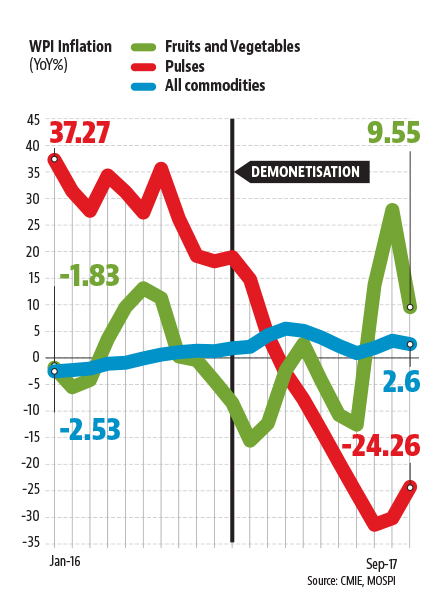
India moves to cashless economy
One of the fundamental effects of Demonetization 2016 has been that more people take made digital payments function of their lives moving towards a cashless economy. The details of growth of such digital transactions since January 2016 to August 2017 reflect that NEFT transactions that involved Rs. 7086 bn increased to Rs.12500 bn; Debit cards transactions increased from Rs.2328 bn to Rs. 2700 bn; credit cards from Rs. 214 bn to Rs.366bn and the IMPS transaction which was non used past the people, got a share of Rs.651 bn. The Data shared by Reserve Bank of India reflect the trend:
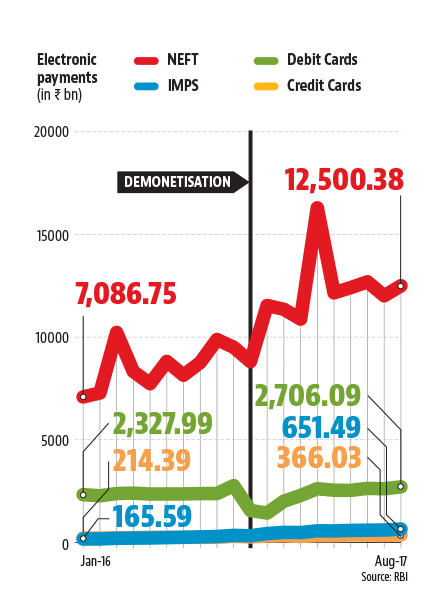
Stock Market gets bullish
Afterwards demonetization stock market place in India got bullish. While BSE index which was 27, 459 on November 7, 2016 rose to 33680.92 on November half dozen, 2017, the NSE rose from 8497 to x,443. The data shared past Bloomberg reflect the tendency.
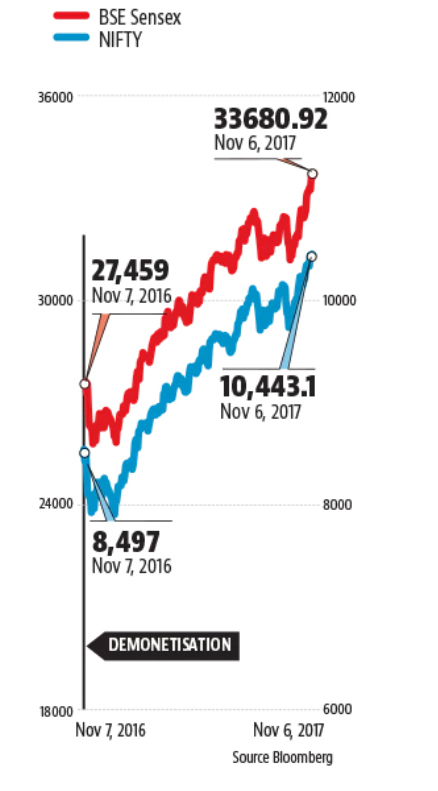
Banks' lending increases for small businesses
Banks' finance to small business organization was going down in pre-demonetization period. There was a negative growth even in short menstruation of months. Every bit on November 25, 2016, a negative growth of -7.71% was recorded in Banks' lending to pocket-size business organization. It went to -8.sixteen% as on Dec 23, 2016. Notwithstanding, as on September 29, 2017 the Reserve Bank of India has reported a positive growth of 1.65% in lending to minor business by the Banks.
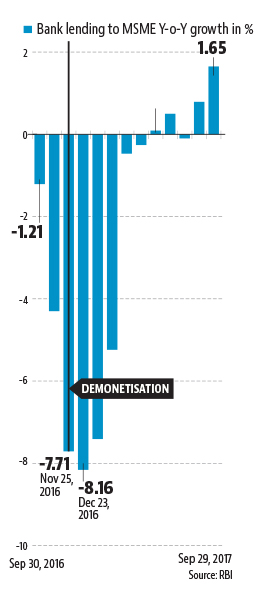
Automobile sales picked up
Sale of 2 wheelers and 4 wheelers was showing a negative growth in 2016. In 2017 it went up essentially and recovered from the touch on of negative growth to high positive growth as reflected in the written report.

More than people apply Mobile wallets than greenbacks
Instead of using cash, more people have started using Mobile wallets for making payments for their regular needs. Fifty-fifty less educated people have learned and switched over to mobile transactions. The volume of transactions which was Rs.22.14 bn in January 2016, had gone upwards to Rs. 83.53bn in January 2017.
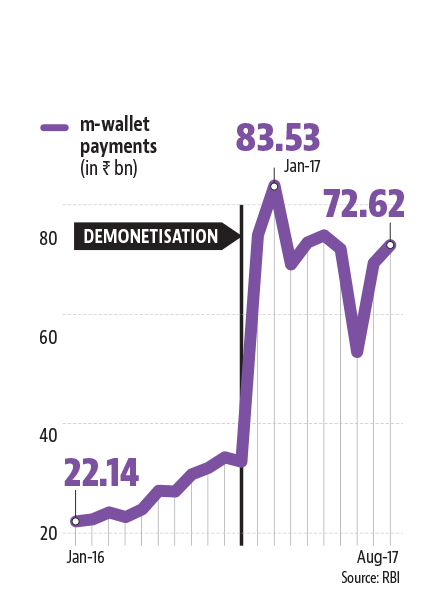
Failures of Demonetization
Economic Growth slows down
Mail demonetization growth of Indian Economy slowed down from 9.1% to 5.7% in less than 1 year. Month-wise GDP growth chart for the menstruum March 2016 to September 2017 as shared by Bloomberg emphasizes this fact as detailed below:
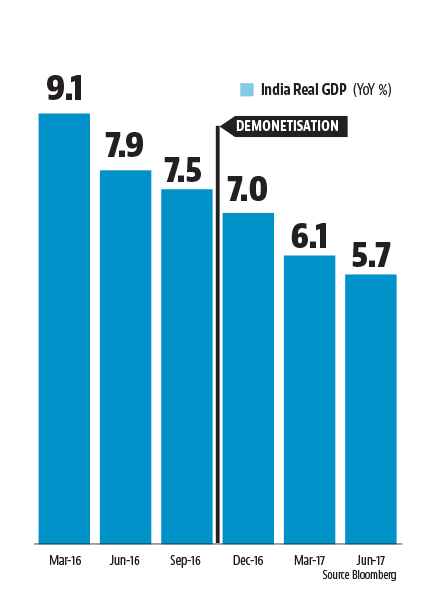
Realty sector bears the brunt
The triple decisions of demonetisation, RERA and GST resulted in a deceleration of new property launches. The supply of new housing units in the top-six cities in India during the first iii quarters of 2017 was down by effectually lx per cent, compared with the corresponding period of 2016.
With respect to holding sales, the secondary market was obviously highly susceptible to demonetisation as compared to the master market. Property transactions in the secondary sales and luxury housing segments tended to take meaning greenbacks components, and such sales have been hampered significantly due to demonetization.
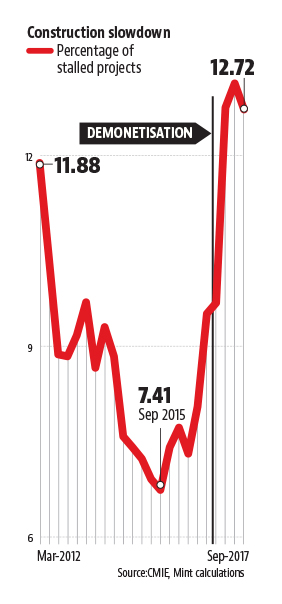
Withal, the shadow of Demonetization now appears to exist fading in reality sector. The prevailing bonny home loan rates, flexible payment plans and other attractive offers by developers, coupled with restricted new supply addition, has led to a steady refuse in the unsold inventory.
As of Q3 2017, only 6,38,500 units remained unsold in the top-6 cities, registering a 9 per cent decline from Q4 2016 levels. The demand for affordable and mid-segment housing has been on a rise.
Initiatives such as interest waivers on home loans, the regime'due south button for affordable housing through Pradhan Mantri Awas Yojana (PMAY) and the 'Housing for all past 2022' mission take come to the forefront over the by 1 year. Various policy initiatives, amendments and reforms were all aimed at making the real manor sector more than transparent, organised and fundamentally stronger. Demonetisation played a significant function in this process.
In the long term, the real estate sector is likely to regain a faster growth trajectory and is estimated to contribute around thirteen per cent to India's gross domestic product by 2028. This optimistic forecast is very much accessible considering the various reforms now redefining the realty mural in Republic of india volition not only incrementally boost consumer sentiment only likewise better investment inflows from foreign and domestic institutional investors.
The Finance Government minister Arun Jaitley on Nov 7, 2017 came out with a spirited defence of demonetisation declaration on November 8, 2016 calling it a "watershed moment for the Indian economy". Co-ordinate to him the demonetization has not just changed the agenda but besides made abuse difficult. Thus, in his opinion, it was not only a "morally and ethically correct" step merely also "politically correct".
Which way to get?
You may go non more than 1 minute while speaking for or confronting or taking a balanced view on demonetization and its bear upon on economy. The but thing is that you lot should be well enlightened about the topic and only this can lead you to speak the style y'all recollect is correct. Besides, once someone else is speaking you may advisedly listen to him and later try to get in and speak out your view point. Please remember do not criss-cross your ain stand.
| GD Topics: Read 200+ GD Topics 2022 for MBA Admissions | |
| Russia Ukraine State of war: Reasons for Conflict & Impact on India | Union Budget 2022: Key Highlights; volition it propel mail pandemic Economic Growth? |
| Crypto Currency: A bright futurity or just a fad | Privatization of Public Sector in India: A right step or selling family unit silver? |
| Social Media: A boon or a bane for guild and individuals | E-Learning: A substitute for Classroom Learning? |
| Is Bharat ready for Electric Vehicles | Coronavirus: Affect of Covid 19 Third Moving ridge in India; Vaccination Policy; Roadmap Ahead |
| Farm Laws Repealed: PM MODI withdraws the three farm laws | Demonetisation: Success & failures |
| Fundamental Banking concern Digital Currency (CBDC): Impact on Indian Financial System & Cryptocurrency | Facebook rebrands to Meta: Is Metaverse a revolutionary technology, or just hype? |
Source: https://www.mbauniverse.com/group-discussion/topic/business-economy/demonetisation
0 Response to "Why Has Demonetisation Become Relevant Again"
Enviar um comentário